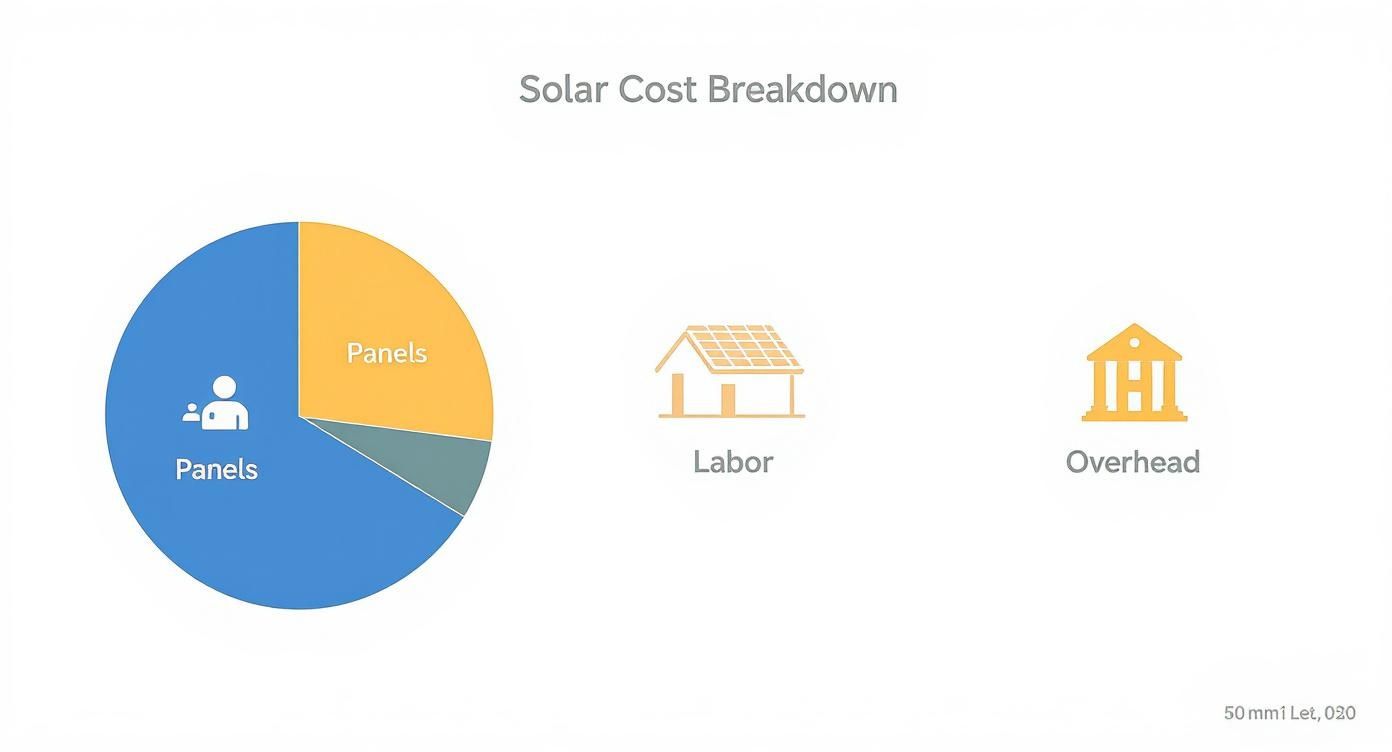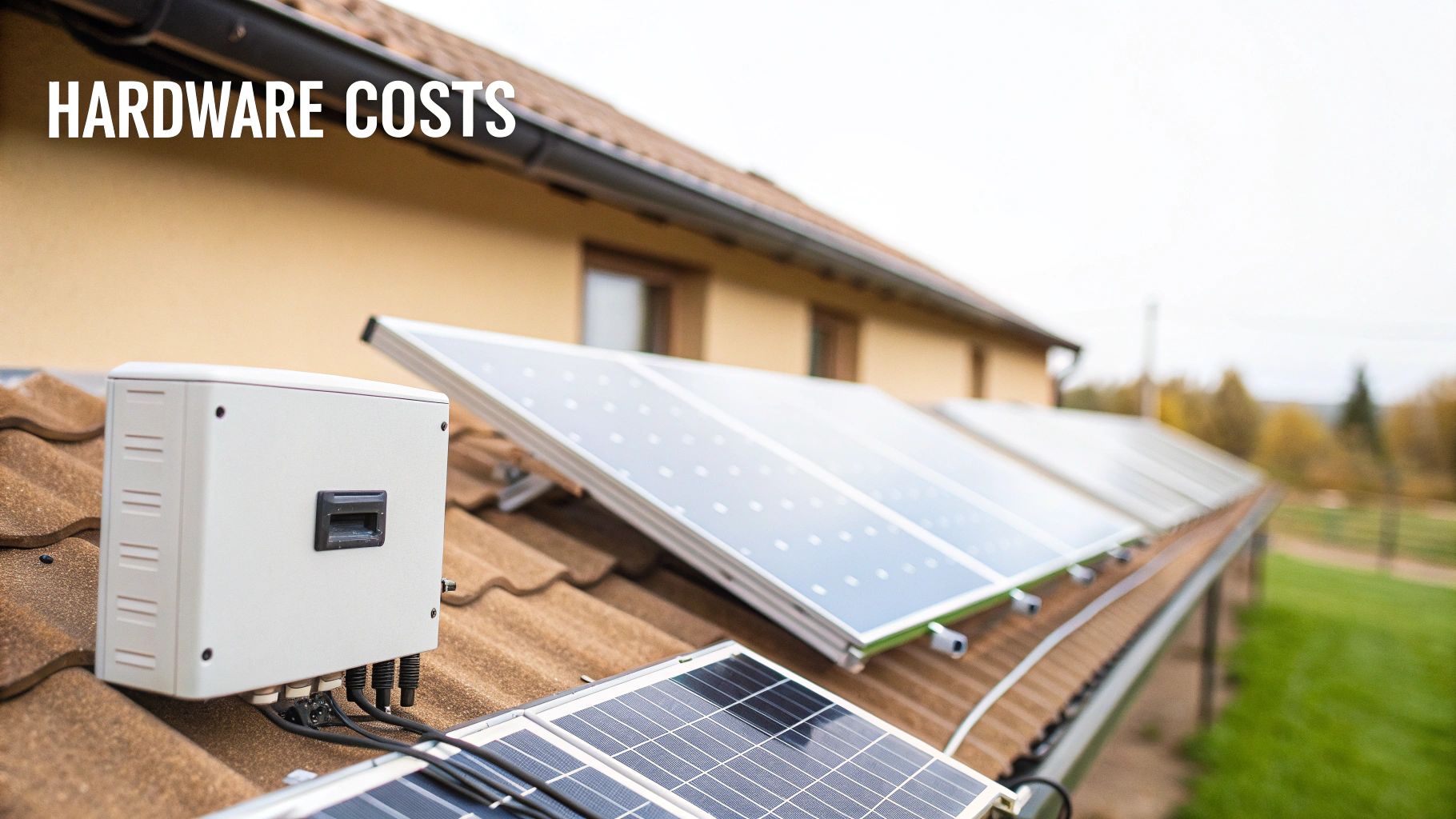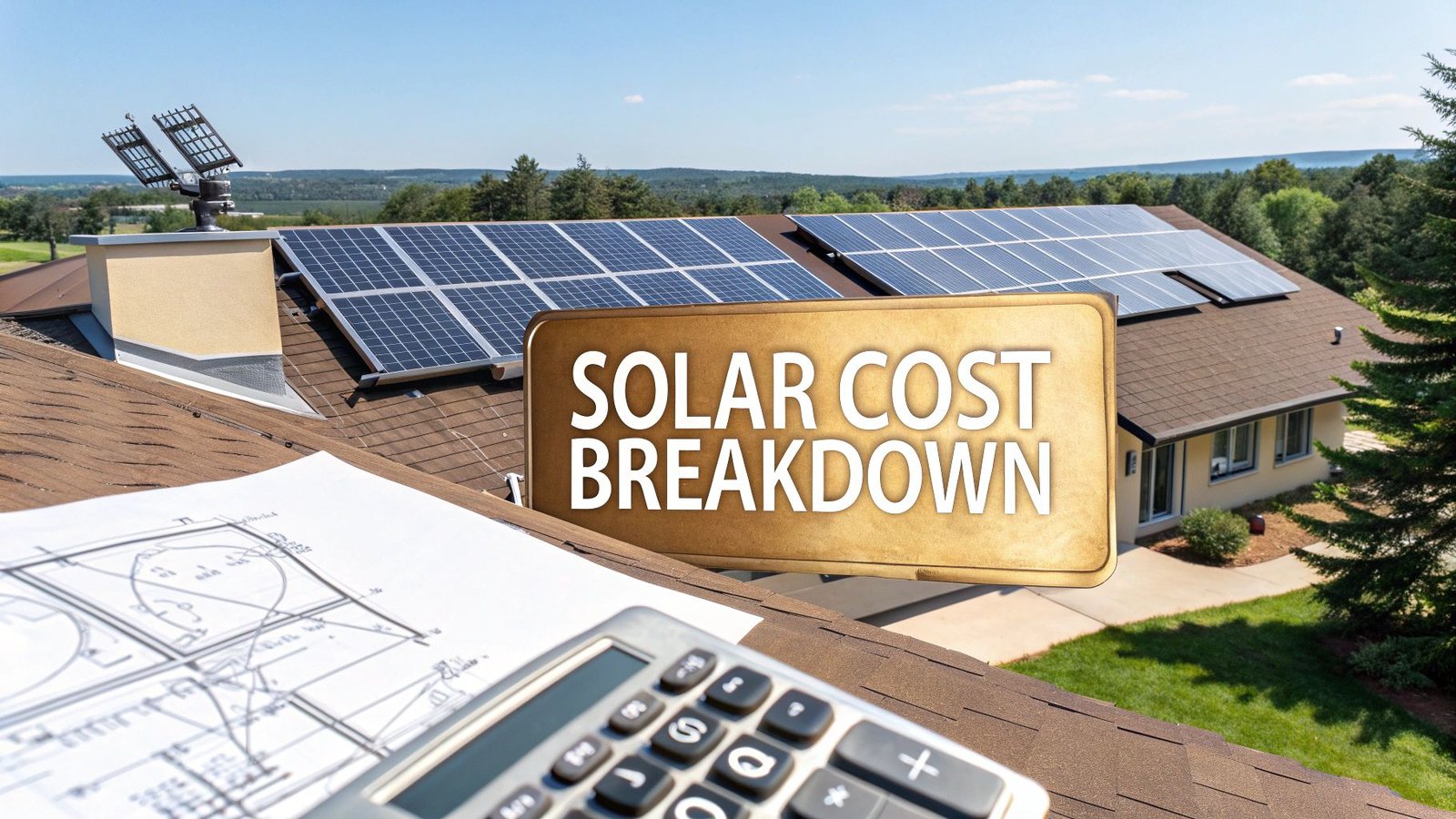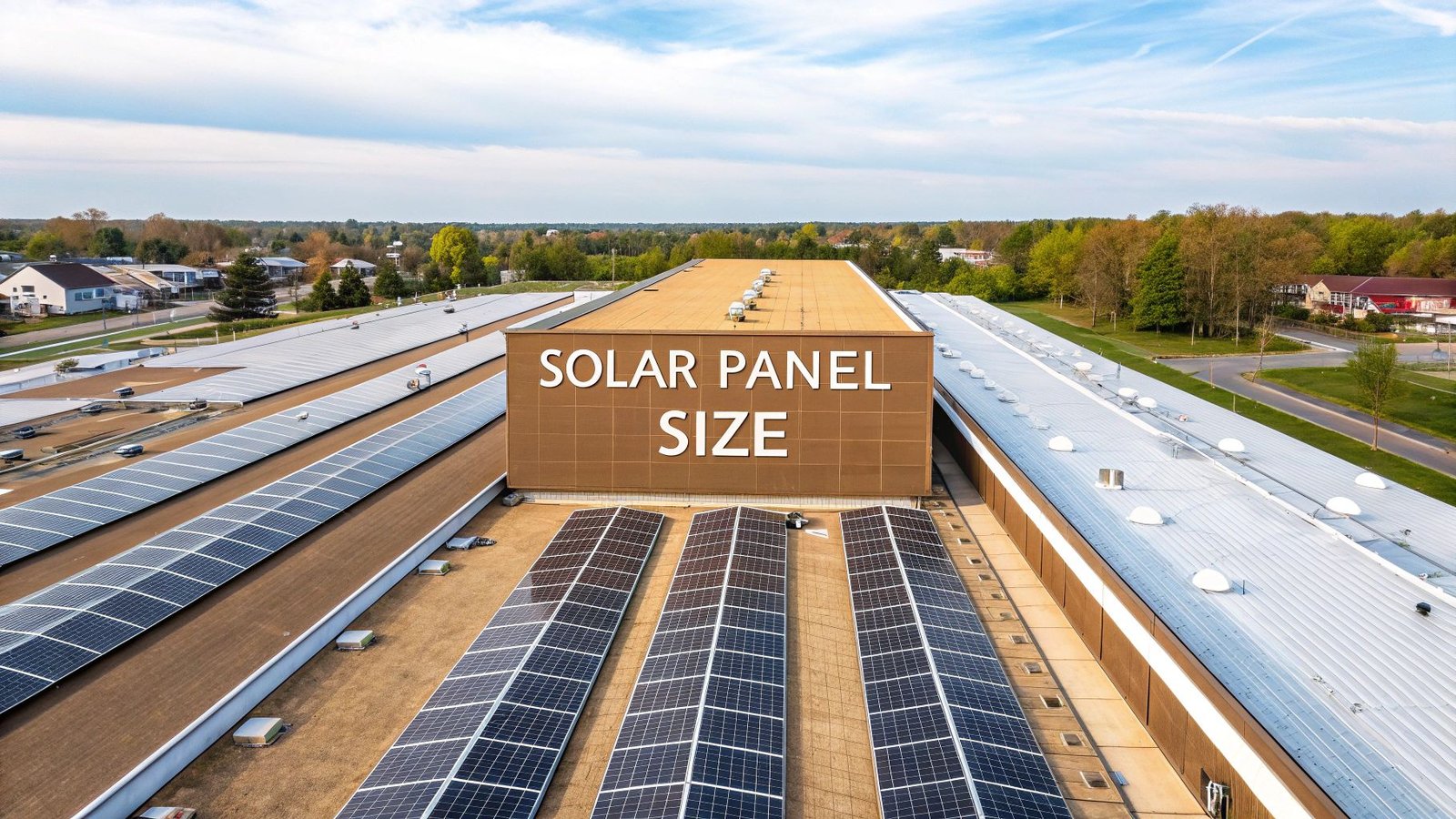When you look at the price tag for a residential solar system, the number that often comes up is around $29,649. But what exactly does that cover? It's easy to assume most of that goes straight to the shiny panels on your roof, but that's only a small part of the story.
This figure is an all-in cost antes de any tax credits or rebates kick in. It bundles together all the essential hardware, the skilled labor to get it installed, and the necessary behind-the-scenes work like permitting and inspections.
Your Quick Guide to Solar Installation Costs
Getting a handle on what you're actually paying for is the first step toward making a smart investment in solar. The final price isn't just for the equipment; it's for a full-service project that ensures your system is safe, efficient, and built to last for decades.
Think of it like building a custom deck. You're not just buying a pile of lumber. You're also paying for the design, the experienced carpenters who build it to code, the permits from the city, and the project manager who makes sure it all comes together seamlessly. Solar is no different.
The main cost buckets you'll encounter are:
- The Hardware: This is the physical gear, including the solar panels themselves, the inverter that converts DC power to the AC power your home uses, and the racking that securely mounts everything to your roof.
- The Labor: You need certified pros to design a system tailored to your home and then install it correctly. Their expertise is a critical part of the investment.
- Soft Costs: This is a catch-all for everything else, from local permit fees and inspection costs to the installer's operational overhead, sales commissions, and administrative work.
A Visual Breakdown of Solar Expenses
This chart gives you a great visual of how a typical solar project budget is divided. It often surprises people to see that the panels are far from the biggest expense.

As you can see, the installer's overhead and the other miscellaneous equipment actually eat up a bigger slice of the pie than the panels. This really drives home the point that you're investing in a complete, professionally managed project, not just a product.
To give you a clearer picture, let's break down the typical costs for a standard 12 kW residential system. The table below shows how the total investment is allocated across different categories before applying any incentives.
Typical Residential Solar Cost Breakdown (12 kW System)
| Cost Component | Percentage of Total Cost | Estimated Cost |
|---|---|---|
| Solar Panels | 12% | $3,558 |
| Inverter & Other Equipment | 23% | $6,819 |
| Installation Labor | 13% | $3,854 |
| Permitting & Inspection | 5% | $1,482 |
| Installer Overhead & Profit | 22% | $6,523 |
| Sales & Marketing | 17% | $5,040 |
| Miscellaneous | 8% | $2,372 |
| Total (Before Incentives) | 100% | $29,649 |
These numbers, based on a 2025 average of $2.53 per watt, show that installation labor accounts for about 10-13% of the total, while the solar panels are only around 12%. The biggest chunks are the installer's overhead (22%) and other essential gear like wiring and warranties (23%).
One final thing to keep in mind is your roof itself. The material can change the complexity and cost of the job. If you have a metal roof or are planning to get one, it's wise to factor in any unique metal roof installation costs to get a truly accurate budget for your entire home improvement project.
Breaking Down Your Solar Hardware Costs
When you get a solar quote, you'll see a mix of costs. While "soft costs" like labor and permits are a big chunk of the bill, the actual physical hardware is the engine that drives your whole system. Getting a handle on what these components are and why they have different price tags is the first step toward making a smart investment.
Think of it like building a custom PC. Every part you choose—from the processor to the motherboard—plays a specific role. The same goes for solar. The main pieces you'll be paying for are the solar panels, the inverters, and the racking system that bolts everything securely to your roof. Let’s look at each one.
Choosing Your Solar Panels
The solar panels are the stars of the show. They’re what everyone pictures—the sleek, dark rectangles that soak up sunlight and turn it into usable electricity (specifically, DC or Direct Current electricity). But not all panels are made the same, and your choice here directly affects your system's power, looks, and price.
You'll generally come across three main types for home installations:
- Monocrystalline Panels: These are the top-tier option. Made from a single, pure silicon crystal, they have a distinctive, uniform black look. More importantly, they're the most efficient, meaning you get more power out of a smaller area. If you have limited roof space, these are often the best bet, though they do come with a higher price tag.
- Polycrystalline Panels: You can spot these by their blue, somewhat speckled appearance, which comes from being made of multiple silicon crystals melted together. They are a bit less efficient than their monocrystalline cousins but are also more affordable. They hit a great sweet spot between performance and value for many homeowners.
- Thin-Film Panels: You won't see these on residential roofs as often. As the name suggests, they are incredibly lightweight and flexible. Their lower efficiency means you need a lot more space to generate the same power, but they're a niche solution for situations where weight is a major issue.
Click to see a chart comparing Solar Panel Types
| Característica | Monocristalino | Policristalino | Capa fina |
|---|---|---|---|
| Eficacia | Highest (18-24%) | Medium (15-20%) | Lowest (10-15%) |
| Coste | Highest | Medium | Lowest |
| Apariencia | Uniform Black | Blue, Speckled | Varies, Flexible |
| Lifespan | Longest | Long | Shorter |
| Lo mejor para | Limited Space | Budget-Conscious | Special Apps (RV, etc.) |
Ultimately, the right panel comes down to a trade-off between your budget, how much energy you need to generate, and how much roof real estate you have to work with. For a deeper dive into the pros and cons, check out our complete guide on cómo elegir paneles solares.
Understanding Solar Inverters
If the panels are the heart of your system, the inverter is the brain. This critical device takes the raw DC electricity your panels produce and converts it into the AC (Alternating Current) electricity that actually runs everything in your house, from your lights to your coffee maker. The type of inverter you get will have a huge say in your system's overall performance and cost.
An inverter’s job is to make solar energy usable for your home. Without it, the power generated by your panels would be incompatible with your lights, television, and outlets.
The two main players here are string inverters and microinverters. A inversor monofásico is a classic, cost-effective choice. It connects a group (or "string") of panels and converts all their power in one central box. This setup works great for simple roofs that get full, consistent sun all day.
The catch? If just one panel in that string gets shaded by a tree branch or a chimney, the output of every other panel in the string drops. This is where microinverters come in. Each panel gets its own small inverter, converting the power right at the source. This means one shaded panel has zero impact on the others, so you squeeze every last drop of energy out of your system. They cost more upfront, but for roofs with complex angles or partial shading, they are almost always the smarter long-term investment.
The Importance of Racking and Mounting Hardware
It’s easy to overlook the racking, but this is the unsung hero of your solar array. This is the industrial-grade framework that holds everything securely to your roof for 25 años o más. It's engineered to handle anything Mother Nature throws at it—high winds, heavy snow, and driving rain—while protecting both the panels and the integrity of your roof.
The cost for racking is directly tied to the type of roof you have. Some are just trickier to work with than others.
Here's a quick rundown of how your roof material can impact the cost:
| Roof Type | Installation Complexity | Racking Cost Factor |
|---|---|---|
| Asphalt Shingle | Standard | Baseline |
| Metal (Standing Seam) | Simple (clamp-on) | Baja |
| Clay or Concrete Tile | Complex (requires special mounts) | Más alto |
| Tejado plano | Requires ballast or tilted mounts | Más alto |
An asphalt shingle roof is the most common and straightforward, making it the least expensive for a solar installation. On the other hand, a beautiful clay tile roof requires a lot more care and specialized mounting hardware to avoid cracking tiles, which drives up labor and material costs. Getting the racking right is non-negotiable for a safe, leak-proof system that will last for decades.
Decoding the Soft Costs of a Solar Project

It’s one of the biggest surprises for homeowners going solar: the actual panels and hardware often make up less than half the total price tag. The real bulk of the cost comes from what we in the industry call “soft costs.”
Think of these as all the essential, non-hardware services that take a stack of equipment and turn it into a high-performing power plant on your roof. You're not just buying solar panels; you're buying a fully managed construction project.
Unpacking Your Labor Expenses
The biggest chunk of your soft costs is almost always labor, which can easily eat up 10-15% of the total project budget. And this is for good reason. You’re paying for a team of certified professionals to handle every detail, from the initial consultation to the moment they flip the switch on your new system.
This isn't just about a few hours spent on the roof. The process is much more involved:
- Initial Site Assessment: An expert has to come out to your home, get on your roof, and check its condition, measure sun exposure, and look for any tricky shading from trees or nearby structures.
- System Design and Engineering: A design team then gets to work, creating a custom solar layout specifically for your home's architecture and your family's energy usage.
- Professional Installation: Then comes the physical work—securely mounting the racking, wiring every panel, connecting the inverter, and making sure every connection is perfect and up to code.
- System Commissioning: Finally, they power up the system, test everything, and make sure it’s generating the electricity you were promised.
This expertise is what ensures your system is not only powerful but, more importantly, completely safe for your home and the public grid.
Demystifying Permits and Interconnection
Before a single bolt is fastened, your solar project has to run a gauntlet of red tape. This means getting the right permits from your local city or county and, crucially, getting approval from your utility company to connect to their grid.
Permitting and inspections are non-negotiable safety measures. They ensure your solar installation meets all local electrical and structural codes, protecting your home and family.
The costs here can vary wildly depending on where you live, covering fees for building permits, electrical permits, and a series of inspections. Properly navigating local building codes is a major part of the job, and it’s something your installer handles so you don’t have to. Trust me, it saves you a world of headaches.
The Installer Overhead Explained
Finally, a slice of your investment goes toward the installer’s overhead. These are the behind-the-scenes business costs that keep a reputable company running and separate the pros from the fly-by-night outfits.
This bucket includes all the things that protect you as a homeowner:
| Overhead Component | What It Covers | Why It Matters for You |
|---|---|---|
| Insurance & Licensing | General liability and workers' compensation. | Protects you from liability in case of an accident on your property. |
| Warranties | Guarantees on workmanship and system performance. | Provides peace of mind that your investment is protected for years. |
| Project Management | Coordination of schedules, materials, and teams. | Ensures your project runs smoothly and is completed on time. |
| Sales & Marketing | Customer education and acquisition costs. | Helps reputable installers reach homeowners like you. |
When you see these items in a solar panel installation cost breakdown, it’s a good sign. It shows you’re not just buying parts; you're investing in a complete, professional service designed to deliver clean, reliable energy for the next 25 años o más.
How Incentives Can Knock Down Your Final Cost
That initial price you see on a solar quote? It's really just a starting point. Think of it like the sticker price on a new car—it’s the number antes de all the good stuff kicks in. A powerful mix of federal, state, and even local incentives can slash your final solar panel installation cost breakdown, making the switch to clean energy much easier on your wallet.
Getting a handle on these programs is the secret to getting the best possible return on your investment. They're designed to give homeowners a serious discount for going solar, which can shave years off your payback period.
The Big One: The Federal Solar Investment Tax Credit (ITC)
The most valuable incentive available to nearly every homeowner in the U.S. is the federal Investment Tax Credit, or ITC. This isn't just a simple rebate; it's a true dollar-for-dollar credit that directly reduces what you owe on your federal income taxes.
For any system installed from 2022 onward, the credit is worth a whopping 30% of your total project cost. And that "total cost" isn't just the panels—it includes the inverter, labor, permit fees, and even a battery storage system if you install one at the same time.
Let's put that into perspective. On a system costing $30,000, the 30% ITC gives you a $9,000 tax credit. That’s $9,000 you don't have to send to the IRS, making it a massive tool for lowering your actual out-of-pocket cost.
To get the credit, you just need to own your system (leasing doesn't count) and have enough tax liability to claim it. If the credit is more than you owe in one year, you can usually just roll the rest over to the next year.
State and Local Incentives: Layering on the Savings
The federal ITC is an amazing start, but the savings rarely stop there. Many states, cities, and local utility companies have their own programs to make the deal even sweeter. These local perks can turn a good solar investment into an absolute no-brainer.
These incentives come in a few different flavors:
- Créditos fiscales estatales: Just like the federal ITC, some states offer their own tax credits you can claim on your state return, chopping down your tax bill even further.
- Reembolsos en efectivo: Some states or utilities offer straightforward cash rebates based on your system’s size. It's a direct payment that lowers your upfront cost right away.
- Incentivos basados en el rendimiento (PBI): In certain markets, you can actually earn money for the power your system generates through programs like Solar Renewable Energy Credits (SRECs).
Because these programs change from one town to the next, you have to do a little digging to see what's available where you live. You can find a detailed list by checking out this guide on solar incentives by state. It will help you make sure you’re not leaving any money on the table.
Stacking Incentives: A Real-World Example
To see just how powerful this can be, let's walk through a quick example for a $30,000 residential solar installation.
Click to see a chart of Incentive Impact on Final Cost
| Tipo de incentivo | Value | Remaining Cost |
|---|---|---|
| Coste bruto del sistema | $30,000 | |
| State Cash Rebate (e.g., 10%) | -$3,000 | $27,000 |
| Federal ITC (30% of gross cost) | -$9,000 | $18,000 |
| Final Net Cost | $18,000 |
As you can see, just layering a couple of common incentives can chop the total cost down by 40% or more. That completely changes the financial math behind going solar.
While these incentives are great for homeowners, they're even more impactful for businesses. Commercial solar panel systems can run anywhere from $1 to $2.50 per watt before incentives. A larger 200 kW system could easily top $400,000. But after the federal tax credit and accelerated depreciation rules kick in, those costs can often be cut in half. It’s a perfect example of how tax policy helps drive solar adoption for projects of all sizes.
Calculating Your Solar Payback Period

It’s easy to look at a solar installation as just another home improvement project. But that’s selling it short. Think of it more like buying a rental property or a dividend-paying stock—it's a long-term financial investment. To really understand its value, you have to look past the upfront price and figure out when it will start paying you back.
That break-even point has a name: the solar payback period. It’s simply the amount of time it takes for the money you save on electricity bills to completely cover the initial cost of the system. After you hit that milestone, every single kilowatt-hour of energy your panels produce for the next Más de 25 años is pure, unadulterated profit.
The Basic Payback Calculation
Figuring out your payback period isn't as complicated as it might sound. At its heart, the calculation is a straightforward division problem that gives you a solid starting point for understanding your solar investment.
The basic formula looks like this:
Payback Period (in years) = Net System Cost / Annual Electricity Savings
Let's quickly unpack those two key numbers. Your net system cost is the final price you actually pay after all incentives—like the 30% federal tax credit and any local rebates—are factored in. Your annual electricity savings is the amount of money you habría sent to the utility company over a year if you didn't have solar panels.
For a more tailored look, our solar return on investment calculator can help you crunch the numbers for your specific home and energy use.
A Step-by-Step Example
Let's walk through a typical scenario to make this crystal clear. Suppose the total installation cost for your system is $30,000. After you claim the $9,000 federal tax credit (30% of $30,000), your net cost drops to $21,000.
Now for the savings. If your average electric bill was $150 per month, that means you were spending $1,800 a year on power ($150 x 12).
Plugging those numbers into the formula:
$21,000 (Net Cost) / $1,800 (Annual Savings) = 11.67 years
In this case, your solar panels would pay for themselves in just under 12 years. Given that most panels are warrantied for 25 años, that leaves you with more than 13 years of completely free electricity.
Understanding Your Return on Investment
While the payback period is a great starting point, smart investors also want to know the Return on Investment (ROI). ROI gives you the bigger picture, showing you how profitable the system will be over its entire lifespan. Most residential solar systems in the U.S. deliver an annual ROI of around 10%, but it’s not uncommon for homeowners to see returns north of 20%.
Think of it this way: a 10% ROI is significantly better than what you’d typically see from the stock market or a high-yield savings account. It’s an investment that not only pays for itself but keeps generating real financial gains for decades.
Several things can speed up your savings and pump up your ROI. The biggest one? The ever-increasing cost of electricity from the utility. Grid power rates have historically climbed by about 2-4% every year. As the utility’s power gets more expensive, the free energy you’re generating on your roof becomes more valuable, which in turn shrinks your payback period.
Locking in Your Energy Costs
Another powerful financial concept here is the Levelized Cost of Energy (LCOE). It sounds technical, but the idea is refreshingly simple. LCOE is your fixed cost to produce solar power over the lifetime of your system.
Imagine being able to lock in today's gasoline prices for your car for the next 25 years. That's what solar does for your electricity. Once your system is paid for, your LCOE essentially drops to zero, making you immune to unpredictable rate hikes from the utility company—forever. Your solar panels transform from a line item in a cost breakdown into a hard-working asset that delivers predictable financial returns.
Why Solar Installation Costs Keep Dropping
If you’ve been keeping an eye on the solar industry for a while, one trend is impossible to miss: prices just keep falling. What was once a super expensive, niche technology has officially gone mainstream, becoming a genuinely affordable solution for homeowners. This isn't just a fluke; it's the result of powerful global trends that are making solar a smarter investment with each passing year.
Understanding why this is happening is key to feeling confident about going solar. This isn't some temporary sale. The continuous drop you see in the solar panel installation cost breakdown is a sign of a mature, tech-forward industry really hitting its stride. Let's break down the three main reasons behind this fantastic shift.
Breakthroughs in Solar Technology
The biggest driver behind lower costs is, without a doubt, huge leaps in the actual photovoltaic (PV) technology. A good analogy is the evolution of computer chips—engineers are constantly figuring out how to squeeze more power into a smaller, cheaper package. The solar panels on the market today are light-years ahead in efficiency compared to models from a decade ago. That means you need fewer panels on your roof to generate the same amount of power.
This boost in efficiency has a direct impact on manufacturing costs. As production techniques get more sophisticated, factories can churn out high-performance panels using less raw material and creating less waste. And the best part? Those savings get passed directly on to you.
The Power of Economies of Scale
As solar has gone from a niche interest to a global phenomenon, manufacturing has ramped up in a massive way. Huge, automated factories can now produce millions of panels at a tiny fraction of the cost of older, smaller operations. This is a classic case of economies of scale at work: the more of something you make, the cheaper each individual item becomes to produce.
This incredible global expansion has fired up a very competitive market. Over the past decade, solar installation costs have taken a nosedive, largely thanks to this scaling of production. Between 2014 and 2025, the average price per watt dropped by about 28%. At the same time, global solar installations surged by an incredible 64% in just the first half of 2025. You can read more about this explosive worldwide growth on e360.yale.edu.
This constant downward pressure on prices is a massive win for homeowners. The global race to build better, cheaper solar technology means you're investing in a system that is more powerful and more affordable than ever before.
More Competition and Efficient Supply Chains
Finally, the entire solar ecosystem—from the factory to your roof—has gotten way more efficient. Years ago, getting all the necessary solar components in one place was a complicated and messy process. Today, it’s a well-oiled machine with streamlined logistics that cut down on transportation costs and annoying delays.
At the same time, the number of qualified solar installation companies has grown significantly. This creates a healthy, competitive local marketplace. When installers have to compete for your business, they're driven to offer better pricing, faster installation times, and top-notch customer service. All this competition ensures that the savings from the factory and the lab make their way all the way down to the final quote you receive.
Got Questions About Solar Costs? We've Got Answers.
Even after you've seen a detailed breakdown of what goes into a solar installation, it's completely normal to have some questions pop up. Getting straight answers to these common concerns is the best way to feel confident about moving forward. Let's tackle some of the most frequent ones we hear from homeowners.
Does the Solar Panel Brand Really Matter for the Price?
You bet it does. The brand you choose has a huge effect on both the initial price tag and what you get out of your system over the next 25 years. Big names like SunPower or LG will cost you more upfront, but they pack a punch with higher efficiency—meaning you get more power out of a smaller footprint on your roof. Plus, they usually come with rock-solid warranties and a track record of lasting a long time.
On the flip side, there are plenty of budget-friendly brands that can get you into the solar game for less. The real trick is finding the right balance for your home. A good installer won't just sell you the most expensive panel; they'll help you compare the cost-per-watt and project how much energy each option will produce over its lifetime. That way, you can see if a premium panel’s extra power is actually worth the higher cost for you.
What Hidden Costs Should I Watch Out For?
A good, honest quote should cover everything, but sometimes surprises pop up once an installer actually gets a good look at your property. These "hidden" costs usually have more to do with your home's current condition than the solar equipment itself.
Keep an eye out for these potential add-ons:
- Roof Repairs: This is a big one. If your roof is getting on in years or has some wear and tear, it needs to be fixed antes de the panels go up. It makes zero sense to install a solar system that will last 25 años on a roof that only has 10-15 years left in it.
- Electrical Panel Upgrades: Older homes often have electrical panels that just aren't built to handle the extra juice a solar system produces. Bringing your panel up to modern standards can add anywhere from $1.500 a $4.000 to the project.
- Trenching: If you're planning for a ground-mounted system instead of a rooftop one, you’ll have to dig trenches to run the wiring from the panels to your house. This is an extra labor and material cost to factor in.
Is It Cheaper to Install Solar on a New Home?
Absolutely, and it's not even close. Building solar into a home from the ground up is almost always cheaper and more straightforward than adding it to an existing house later on. The roofers and electricians are already there, so labor costs are lower. And running wires through open walls is a lot easier than fishing them through finished drywall.
When you integrate solar into a new build, it becomes part of the home's design. Architects can angle the roof for perfect sun exposure, and the whole system is baked right into the electrical plan from the start.
This kind of pre-planning sidesteps many of the logistical headaches of a retrofit project, resulting in a cleaner installation and, ultimately, a better-looking final product.
Ready to see what a clear, transparent solar quote for your home looks like? The team at Energía radiante specializes in designing custom solar solutions with no hidden surprises. Contact us today for a free, no-obligation quote!




